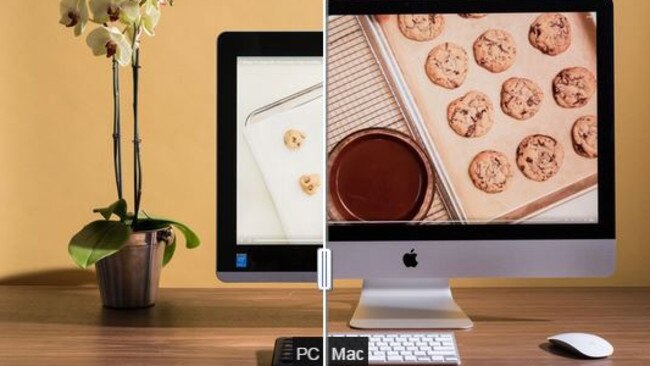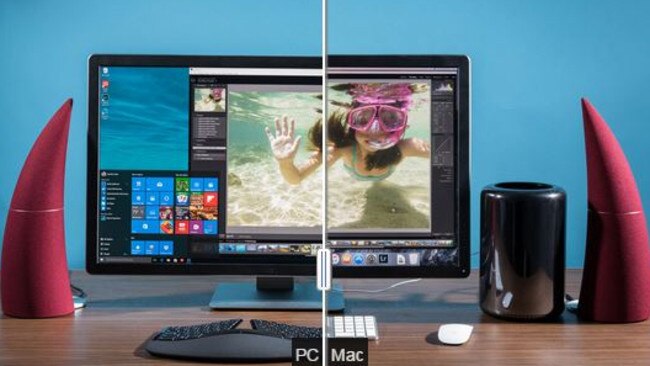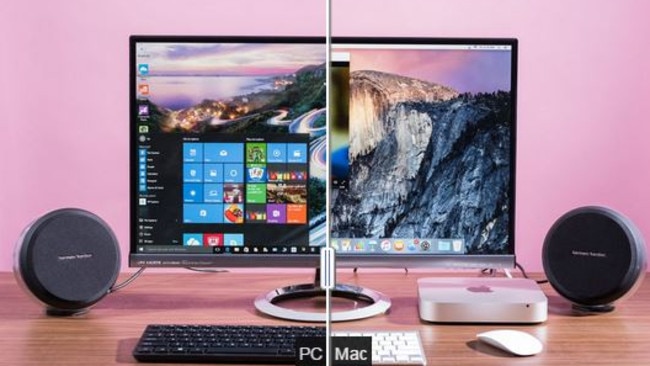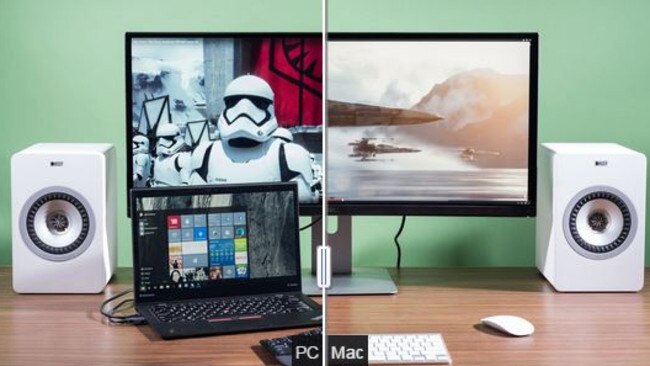Which laptop should I buy? Get a desktop instead
The right desktop — or souped up workspace — can help you get more done comfortably than your lonely laptop.
I get asked for advice on very practical but personal matters. “How do I block my boss on Facebook?” “Can I take back an email I just sent my ex?”
The most frequent question is: “Which laptop should I buy?” To me, that’s like asking which Lunchable to feed your first-grader. I like to answer by challenging the assumption that that’s all there is. Forget the laptop, have you considered a desktop?
Even in our buzzing mobile world, I’m a fan of the stationary desktop computer—or at least the well-appointed desk. I understand how old-fashioned that sounds. After I effused about my desktop setup to a senior Silicon Valley exec a few months back, he asked if I also rode a horse and buggy.
Nobody needs to defend laptops, which now make up 80% of the consumer market, according to market research firm IDC, and remain by far the best way to work on the go. But it’s easy to forget that even the best laptops are inherently compromised.
I’ll go a step further: Not only do desktops offer ergonomic comfort and performance at more reasonable prices, but in our cloud-connected world, they’re once again relevant. My ability to start on a document (or photo or book or video or spreadsheet or movie) at the office, then pick right up at home, means I’m now less wedded to one laptop than ever.
To test that theory, I rustled up eight very different new desktops—all-in-ones, minis and towers—as well as some giant monitors. I found the desktop has come a long way in aesthetics and convenience since the beige boxes we use to buy from the dude at Dell. I’ve picked four setups worth consideration for a table in your home office, kitchen or man cave/ma’am cave.
When I’m feeling creative or needing to focus, there’s no more perfect computer than a 27-inch iMac—complete with mouse, keyboard and widescreen—which now costs up to $2,000 (AU$2758) for its pixel-melting Retina 5K model. (Note: Apple and other desktop makers are expected to announce at least minor refreshes in the coming weeks.)
Yet I’m also impressed by the quality, and now even price, of stand-alone monitors that can transform any computer, even a laptop you already own, into your personal Mission Control. My advice: It’s time to think big.
The joy of the desktop starts with the realization that not all computing tasks are equally mobile. These days, smartphones fill our lives with email, messaging and Facebook in transit, the elevator and boring meetings. But for most of us, the serious work happens in the same one or two places every day. So why not use computer setups best designed for those places?
The current crop of all-in-one desktops, including both the iMac and PC alternatives like the Acer Aspire Z3, are designed for actual human bodies. Ergonomists who study productivity say screens should be level with our eyes, and elbows should be at about 90 degrees while we’re typing. That’s just not possible when you’re slouched over a tiny laptop keyboard.
A desktop can also look nice. These all-in-ones now come in shapes, sizes and colors to actually fit into a house like furniture. They’ve got cameras, microphones and speakers built in, so they can double as entertainment systems and grandparent-friendly videophones.
And the arrival of technologies like voice commands in Windows 10 makes having one in a public space like the kitchen more interesting. (When your fingers are covered in cookie dough, just call out, “Hey, Cortana, how many calories are in a snickerdoodle?”)
Desktop computers are also a value. It makes sense that you pay a premium to shrink down and ruggedize the components of a laptop. But I compared performance and prices to put a figure on it: Desktops typically give you 50% to 100% more screen real estate per dollar. For example, an iMac with a 27-inch Retina 5K screen costs the same as the similarly powered 15-inch Retina MacBook Pro.
And the great diversity of PC and component makers means you can also put together a customized machine on the cheap, though it might take a little work.
If it’s power that matters, desktops can provide more per dollar because they offer more space and fewer power concerns than a laptop. Dell gave me an early peek at its smokin’ new XPS 8900, a soon-to-be-launched top free-standing tower computer. It contains Intel’s Core i7-6700K processor, one of the new chips awesomely code-named Skylake.
This tower of power, which looks like Darth Vader’s PC and can cost as little as $700 (AU$965) and as much as several thousand, blasted through the photos, video and games I sent its way. It also has photographer-friendly features built in, like multiple-sized memory card readers and a plethora of USB ports, right on top. And as any PC gamer will tell you, being able to customize—and perpetually upgrade—a desktop tower makes it last longer.
There are certainly less expensive, and less space-consuming, ways to get a digital hub for your home. Computers like the HP Pavilion Mini and Apple’s Mac Mini pack enough power to do most modern computing tasks in less space than a TV dinner, for a few hundred bucks. They don’t contain the latest processors, but these are a good choice for a child’s starter computer, or a little Internet box for the living room. Plug one of these into an old monitor or even a TV, and you’ve got a place to store family photos and music. Pair it with a wireless mouse and keyboard from AmazonBasics, which cost just $24 (AU$33).
My favorite aspect to both towers and minis is the incredible displays they can now drive. Over the past year, 4K monitors—which have four times the resolution of a high-def TV—have come down from the stratosphere in price. AOC even makes a 28-inch model that costs $350 (AU$482), though I’d recommend spending more for the Acer 28-inch XB280HK, which sells online for around $700 (AU$965). If price isn’t a concern, drop $2,000 (AU$2758) on Dell’s 32-inch 4K monitor, which looks gorgeous from any angle.
That takes us to what’s probably the most practical setup of all: the laptop landing pad. If you lug a powerful laptop everywhere for work, you can at least make better use of it at home with a huge screen and an ergonomic keyboard and mouse like Microsoft’s excellent Sculpt series. (One study found 17% higher productivity among people who use a laptop with a separate mouse and keyboard instead of a laptop without accessories.)
I fell in love with new curved monitors, such as a $1,200 34-inch version (AU$1654) from Dell that’s like two screens fused together. While that display has OK built-in speakers, you can add high-resolution audio and write-home-to-mama sound with KEF’s $800 X300A speakers (AU$1103) which connect via USB.
Maybe your bottom-line-minded employer didn’t give you a supercharged laptop that could be the star of your well-appointed desk. Skip the crazy monitor and go back to the Mac. I use my 27-inch iMac to work on Google Docs in the cloud and edit my personal photos. And when it’s a lovely summer day to sit on the porch and write or read, I carry an iPad and keyboard combo (Moshi’s $100 (AU$137) VersaKeyboard) that’s half the weight of my laptop. The work-issued Windows laptop stays docked at the office except when I take a long business trip.
The cloud, and dropping prices for all computers, means we’re less tied to one device to do everything. Given all the choices, it’s a desktop you’ll want to come home to.

WSJ Tech columnist Geoffrey A. Fowler picks four setups:
ALL-IN-ONE BEAUTY
THE SETUP: 27-inch iMac Retina 5K ($2,000 (AU$2758) and up) or 24-inch Acer Aspire Z3-710 ($900 (AU$1241) and up).
WHO IT’S FOR: People who want to keep it simple, yet have the ergonomic advantages of a desktop computer, or families looking for a shared home base.
WHY IT ROCKS: Remarkably powerful, with big screens that look great in any office, family room or kitchen.
THE CAVEAT: These machines are essentially vertical-standing laptops, which means you can’t always upgrade pieces easily.

TOWER OF POWER
THE SETUP: Dell XPS 8900 ($700 (AU$965) and up) or a Mac Pro ($3,000 (AU$4137) and up), 32-inch Dell UltraSharp 4K monitor ($2,000 (AU$2758)), horn-styled Edifier Spinnaker speakers ($300 (AU$413)), Microsoft Sculpt Ergonomic Desktop ($130 (AU$179)).
WHO IT’S FOR: Multimedia gurus and serious part-time gamers.
WHY IT ROCKS: Spare no expense on just what matters most to you, be it processor horsepower, screen size or audio. Easy to upgrade one piece at a time.
THE CAVEAT: This husky model may require its own hideaway in your man (or ma’am) cave, as well as some basic PC know-how to make components work together. Expensive extra high-end processors may only be helpful with the right software.

MINI BUT MIGHTY
THE SETUP: HP Pavilion Mini ($270 (AU$372) and up) or Mac Mini ($500 (AU$689) and up), AmazonBasics wireless mouse and keyboard ($24 (AU$33)), Harman Nova speakers ($300 (AU$413)), spare TV or monitor.
WHO IT’S FOR: Families looking for a budget computer.
WHY IT ROCKS: The least expensive way to get a digital hub for your house.
THE CAVEAT: You can change monitors any time, but internal components can’t be easily upgraded.

LAPTOP LANDING
THE SETUP: Dell UltraSharp 34 monitor ($1,200 (AU$1654)), KEF X300A speakers ($800 (AU$1103)), Microsoft Sculpt Ergonomic Desktop ($130 (AU$179)), and a laptop you already own.
WHO IT’S FOR: Laptop owners who want to the ergonomic, display and audio benefits of a full desktop.
WHY IT ROCKS: Turns your existing machine into a rocking desktop experience, so you don’t have to maintain multiple primary computers.
THE CAVEAT: A weak laptop may not keep up with the latest monitors. Will require a docking station or some futzing with cables.
View the original article and view the comparison images as interactive sliders at The Wall Street Journal


